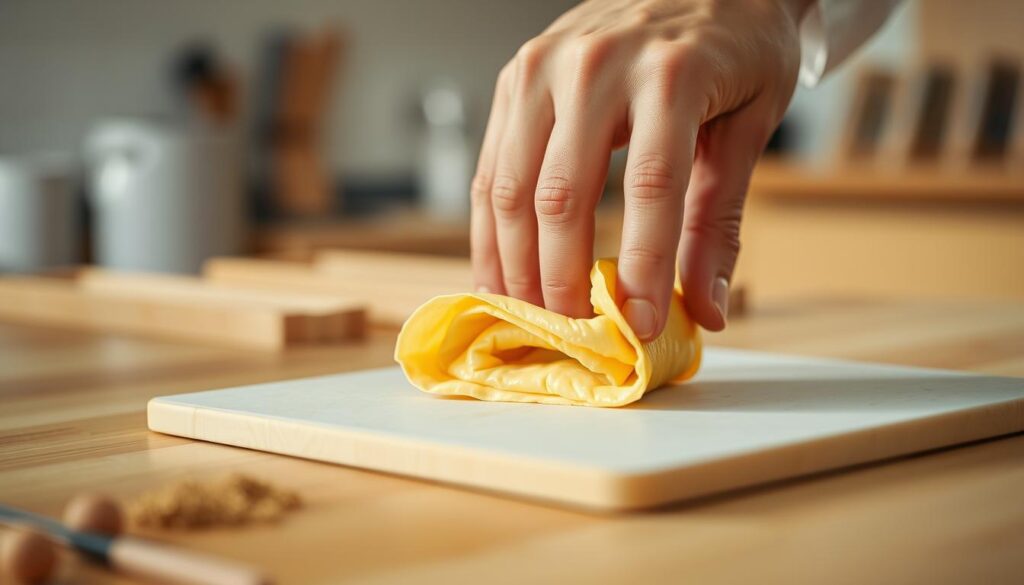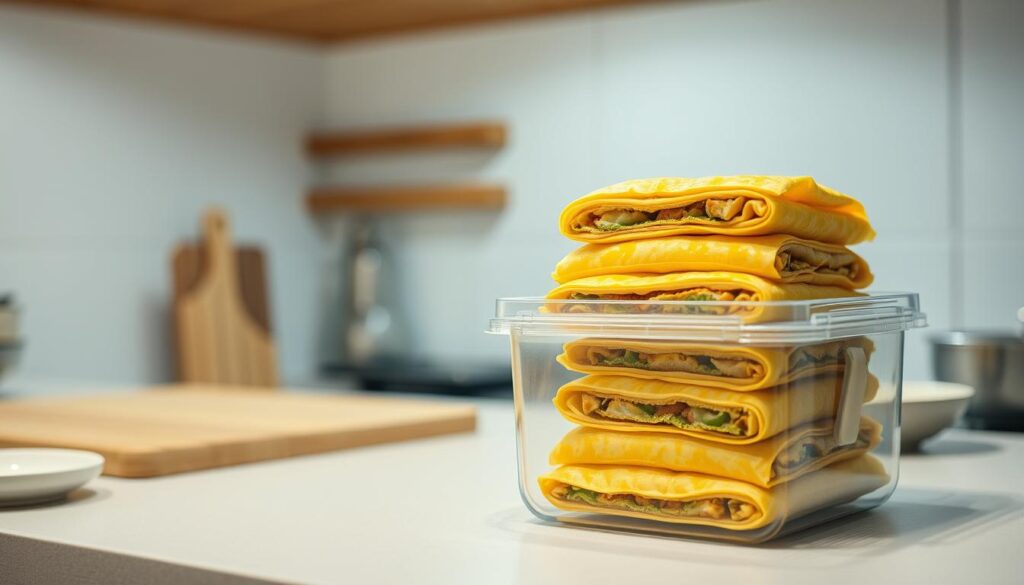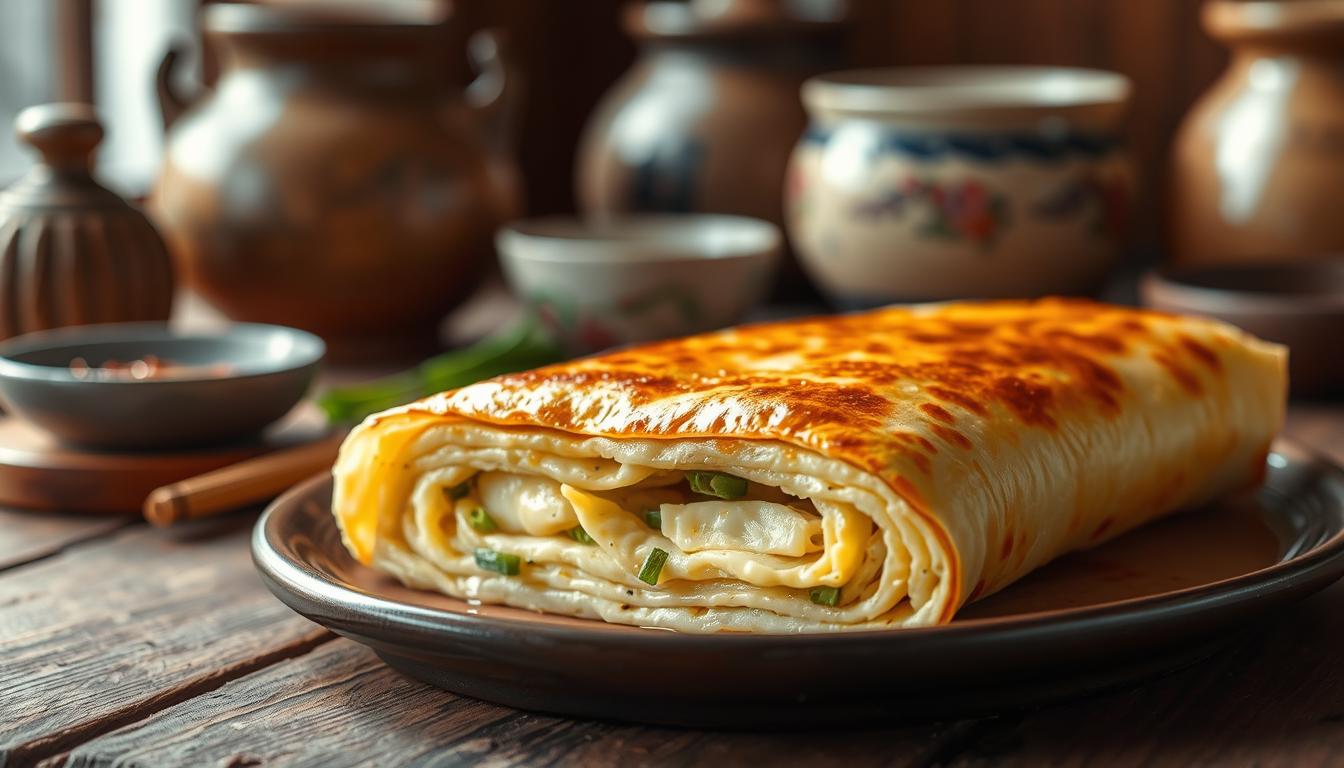The first time I tried a Korean rolled omelette, or gyeran-mari, it was amazing. The eggs were cooked just right, and the veggies peeked out from each fold. The taste was rich and delightful.
This Korean egg roll is more than a recipe. It’s a celebration of simplicity and skill. Whether you’re a home cook or a food lover, this guide will show you how to make a delicious Korean rolled omelette.
You’ll learn how to layer eggs and roll them perfectly. You’ll see how simple ingredients can become a stunning dish that looks and tastes amazing.
Key Takeaways
- Learn the authentic technique for making Korean rolled omelette
- Discover the importance of precise egg layering
- Understand the cultural significance of gyeran-mari
- Master the rolling technique for perfect presentation
- Explore versatile serving and ingredient options
Introduction to Korean Rolled Omelette (Gyeran-mari)
The korean-style omelette, known as gyeran-mari, is a treasure in Korean cuisine. It has won the hearts of food lovers everywhere. Its unique preparation and rich flavors make it special.
Cultural Significance in Korean Cuisine
Gyeran-mari is key in Korean meals. It’s a flexible dish that fits into many situations:
- Served as a banchan (side dish) in family meals
- Popular in work and school lunch boxes
- Commonly prepared in almost every Korean household
Popular Variations and Names
The korean omelet is known by many names. It can have different vegetables, like:
- Onions
- Bell peppers
- Carrots
- Green onions
Brief History of the Dish
“Gyeran-mari represents more than just a meal – it’s a culinary tradition passed through generations.”
The dish has a long history. It started as a tasty way to add protein and veggies to meals. This shows Korean cooking’s creative side.
Essential Ingredients for Perfect Korean Egg Roll
Making a real gaeran-mari needs the right ingredients. This Korean egg dish is all about mixing fresh parts to make eggs into a work of art.
Key Egg Mixture Components
The base of the rolled eggs is top-notch eggs. For a great Korean egg roll, use:
- 5 large, fresh eggs
- 1/4 teaspoon kosher salt
- Optional: 1-2 tablespoons milk or broth for extra fluffiness
Vegetable and Seasoning Options
Vegetables are key in jidan-guan, adding texture and taste. Common choices are:
- 1 tablespoon finely chopped green onions
- 1 tablespoon diced carrots
- 1 tablespoon yellow onions
- Optional: mushrooms, bell peppers
Seasonings boost the flavor. Common ones are:
- A pinch of black or white pepper
- Optional: soy sauce or sesame seeds for garnish
Optional Flavor Enhancers
To spice up your Korean egg dish, try these:
- Diced ham or spam
- Crab meat
- Prawns
- Vegetarian options like spinach or zucchini
Pro tip: Always use fresh ingredients and chop vegetables finely for the best texture in your gaeran-mari.
Kitchen Tools and Equipment Needed
To make perfect omelet rolls, you need the right kitchen tools. These tools make cooking egg wraps fun and easy. The right equipment can also improve your cooking skills and help you become a pro at gyeran-mari.
- Non-stick rectangular pan (ideally 5-7 inches)
- Flexible spatula or wooden chopsticks
- Bamboo mat or plastic wrap for shaping
- Sharp knife for precise cutting
Here’s a detailed breakdown of recommended equipment for making egg wraps:
| Tool | Price Range | Recommended Brands |
|---|---|---|
| Tamagoyaki Pan | $18.99 – $84.99 | Techef, ROCKURWOK |
| Nonstick Pan | $20 – $30 | Lisos, SENSARTE |
| Spatula Set | $15 – $25 | FUNGYAND, Ibili |
Pro tip: For beginners, a nonstick pan around $22.99 with a rectangular shape works best for creating smooth omelet rolls. Copper pans offer superior heat conductivity but are recommended for more experienced cooks.
“The right tools can turn a good Korean egg wrap into an exceptional culinary experience.”
When choosing your equipment, think about handle length, pan weight, and surface material. Most recommended pans weigh between 12.4 ounces and 1 pound. Handle lengths up to 6.5 inches make handling easier.
Preparation Tips and Techniques
Creating a perfect Korean egg roll needs focus and skill. Whether you’re into korean street food or making a traditional korean egg dish, these tips will improve your gyeran-mari skills.
Knowing the basic preparation methods can make your egg roll stand out. Let’s explore the key techniques for a top-notch korean street food experience at home.
Proper Egg Beating Method
Beating your eggs right is key to a smooth egg roll. Here’s how to do it:
- Use fresh eggs at room temperature
- Whisk eggs thoroughly for 2-3 minutes
- Strain the mixture to remove any stringy egg whites
- Add a pinch of salt to enhance flavor
Vegetable Cutting Techniques
Getting your vegetables cut just right is essential for a real egg roll:
- Chop vegetables into ultra-fine pieces
- Aim for consistent 1/8-inch dice
- Use sharp knives for clean cuts
- Mix vegetables evenly throughout egg mixture
Pan Temperature Control
Controlling the pan temperature is key when cooking your korean egg dish:
| Cooking Stage | Temperature | Duration |
|---|---|---|
| Initial Heating | Medium-Low | 1-2 minutes |
| Egg Layer Cooking | Low | 1-2 minutes |
| Final Rolling | Low-Medium | 30 seconds |
“Perfect temperature control transforms a simple egg roll into a culinary masterpiece.” – Korean Culinary Expert
By using these preparation techniques, you’ll make a delicious korean egg roll. It will look great and taste amazing.
Korean Rolled Omelette: The Rolling Process
Making a perfect Korean-style omelette is all about rolling. Your skill in rolling will affect the dish’s texture and look. Let’s explore how to make a stunning rolled egg that will wow food lovers.
The rolling process needs careful technique and focus. First, grease your non-stick pan lightly. Then, pour a thin layer of egg mix, making sure it covers the whole pan.
- Cook the first layer until it’s almost set but still a bit runny on top
- Start rolling from one side of the pan with a spatula
- Push the rolled part to one side of the pan
- Add more egg mix to fill the empty space
Here’s what you need for your egg rollup:
| Ingredient | Quantity |
|---|---|
| Large eggs | 4-6 eggs |
| Green onions | 1 tablespoon, finely chopped |
| Carrots | 1 tablespoon, finely chopped |
| Salt | 1/4 teaspoon |
Pro tip: Use medium-low heat to avoid burning and ensure even cooking. Each layer should take about 30 seconds to set. The secret to a great Korean rolled omelette is patience and consistent technique.
“The beauty of the egg rollup is in its delicate layers and smooth rolling motion” – Korean Culinary Experts
Keep adding egg mix and rolling until you have a beautiful multi-layered egg wrap. The result should be a tight, evenly rolled omelette with soft layers that show off your cooking talent.
Common Mistakes to Avoid While Rolling
Making a perfect Korean omelet takes skill and practice. Even skilled cooks can face challenges when making egg roll ups. Knowing common mistakes helps you make beautiful, consistent rolled eggs.

Temperature Control Challenges
Temperature is key for smooth omelet rolls. Cooking too hot can cause problems:
- Burning the egg mixture quickly
- Creating uneven cooking surfaces
- Preventing proper layer formation
“The secret to perfect Korean rolled omelettes is mastering your pan’s temperature.”
Rolling Technique Mistakes
Rolling your Korean omelet needs precision. Common mistakes include:
- Rolling Too Loosely: Results in uneven, messy egg rolls
- Rolling Too Tightly: Can cause tearing and breakage
- Inconsistent Layer Thickness: Impacts overall texture and appearance
Pro tip: Practice makes perfect. Start with small batches and gradually improve your rolling skills to create picture-perfect Korean egg roll ups every time.
Serving Suggestions and Pairings
Your gyeran-mari is ready, and now it’s time to elevate your Korean cuisine experience. The versatile korean egg roll can transform any meal from ordinary to extraordinary.
When serving your korean street food favorite, consider these delightful pairing options:
- Accompany with traditional banchan (side dishes)
- Serve with steamed short-grain rice
- Offer ketchup or soy-based dipping sauces
- Garnish with finely chopped green onions
“A well-served gyeran-mari turns a simple meal into a culinary celebration of Korean flavors.”
For a complete dining experience, create a balanced plate with multiple components. Your korean egg roll can be the star of breakfast, lunch, or a light dinner.
| Meal Type | Recommended Pairings |
|---|---|
| Breakfast | Rice, cucumber salad, hot tea |
| Lunch | Radish salad, kimchi, light soup |
| Dinner | Potato stir-fry, pickled vegetables |
Remember, the key to enjoying gyeran-mari is creativity and personal taste. Don’t be afraid to experiment with different accompaniments and discover your perfect combination!
Storage and Reheating Guidelines
Keeping your gaeran-mari fresh is key. Whether it’s a traditional Korean egg wrap or a jidan-guan twist, follow these tips. They’ll help keep your dish tasting great.
Refrigeration Best Practices
Store your Korean rolled omelette in the fridge for 3-4 days. Here’s how to keep it fresh:
- Wrap each gaeran-mari in plastic wrap
- Put them in an airtight container
- Keep it in the coldest part of your fridge
Reheating Techniques
There are several ways to enjoy your leftover Korean egg dish:
- Microwave Method: Heat for 30-45 seconds at 50% power
- Stovetop Technique: Warm in a non-stick pan for 1-2 minutes
- Cold Serving: Enjoy straight from the fridge with hot rice

Safety and Quality Preservation
Follow these storage tips for the best taste and texture. Always check for spoilage before eating.
“Proper storage is the key to maintaining the delicious flavor of your homemade gaeran-mari!” – Korean Culinary Experts
| Storage Method | Duration | Recommended Technique |
|---|---|---|
| Refrigeration | 3-4 days | Airtight container, plastic wrap |
| Microwave Reheating | 30-45 seconds | 50% power setting |
| Stovetop Reheating | 1-2 minutes | Low heat, non-stick pan |
Variations and Creative Adaptations
The korean-style omelette is super versatile for cooking. You can turn a simple dish into a unique masterpiece with a few tweaks.
- Protein-Packed Versions
- Ham and cheese rolled egg
- Spam-infused korean-style omelette
- Seafood-enhanced egg rollup
- Vegetarian Alternatives
- Tofu-based rolled egg
- Plant-based protein fillings
- Mushroom and vegetable combinations
Mixing different cuisines can add exciting twists to recipes. Adding ingredients from around the world can make your egg wrap truly special.
“Cooking is about innovation, transforming classic dishes into personal culinary expressions.” – Korean Cooking Enthusiast
Try using American cheese, Mexican spices, or Mediterranean herbs in your rolled egg. The goal is to mix flavors well while keeping the dish’s Korean essence.
Your korean-style omelette can be a blank canvas for your creativity. It’s all about what you imagine and what you like to eat.
Conclusion
Learning to make gyeran-mari is more than just a new recipe. It’s a journey into Korean cuisine’s heart. This dish is a mix of nutrition, tradition, and taste. It’s packed with 157 calories, 10.6g of protein, and vitamins B12 and riboflavin.
By mastering the art of gyeran-mari, you’ve unlocked a piece of Korean culture. You’ve learned more than just how to cook. You’ve discovered a way to turn simple ingredients into a masterpiece. Whether it’s for breakfast or a side dish, your skills will wow everyone.
Cooking is all about trying new things and adding your own twist. Every time you make a Korean rolled omelette, you’ll get better. Enjoy the flavors and keep exploring Korean cooking traditions.
FAQ
What is a Korean rolled omelette (gyeran-mari)?
Gyeran-mari is a Korean egg dish made by cooking eggs in thin layers. It’s then rolled into a neat shape. This dish is loved as a street food and a home favorite, with eggs, veggies, and seasonings.
What ingredients do I need to make a Korean egg roll?
You’ll need eggs, salt, sugar, and optional veggies like green onions and carrots. Soy sauce or mirin can add flavor. Use fresh eggs and chop veggies finely for even layers.
What type of pan is best for making gyeran-mari?
A non-stick pan is key for gyeran-mari. It prevents eggs from sticking and makes rolling easier. A rectangular pan helps in creating uniform layers.
How difficult is it to roll a Korean omelette?
Rolling a Korean omelette might seem hard at first. But with practice, you’ll get the hang of it. Pour thin egg layers, use a spatula or chopsticks, and roll gently but firmly.
Can I make variations of the traditional gyeran-mari?
Yes! You can try different veggies, add ham or spam, or make vegetarian versions. Some even mix in different flavors for a unique twist.
How long can I store Korean rolled omelettes?
Store gyeran-mari in an airtight container in the fridge for 3-4 days. Reheat in a microwave or enjoy cold, often with rice or as a side.
Is gyeran-mari typically served hot or cold?
Gyeran-mari can be enjoyed both hot and cold. It’s a versatile dish, great as a side, breakfast, or quick snack in Korean cuisine.
What are some common dipping sauces for Korean egg rolls?
Soy sauce, ketchup, or a simple soy-based sauce are favorites. Some also like it with grated daikon radish and soy sauce.
Can I make a vegetarian version of gyeran-mari?
Yes, use plant-based egg substitutes or focus on veggies. Tofu, nutritional yeast, and various veggies can mimic the texture and flavor.
What makes Korean rolled omelettes different from Western-style omelettes?
Gyeran-mari is unique due to its thin layers and tight rolling. It aims for beautiful, uniform layers with a smooth texture, unlike Western omelettes.

